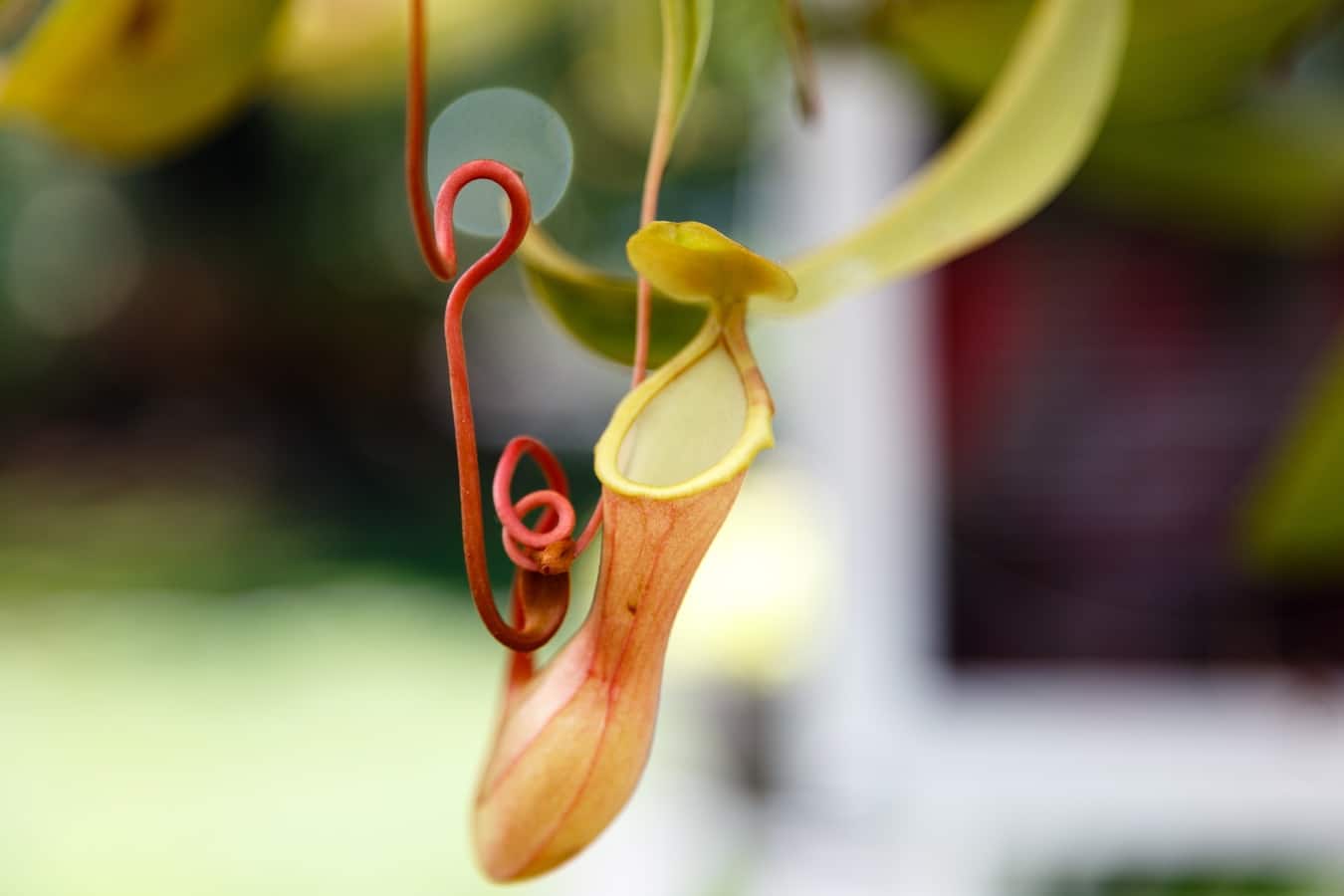
There is a genus of plants carnivorous that attract millions of people from all over the world, are the Nepenthes. Some plants whose traps have a "lid" like a hat to prevent excessive water from entering.
But How are they cared for? Its maintenance is not always easy, so below we offer you a series of tips that we hope will be useful for you so that you can enjoy your carnivore.
Origin and characteristics of Nepenthes
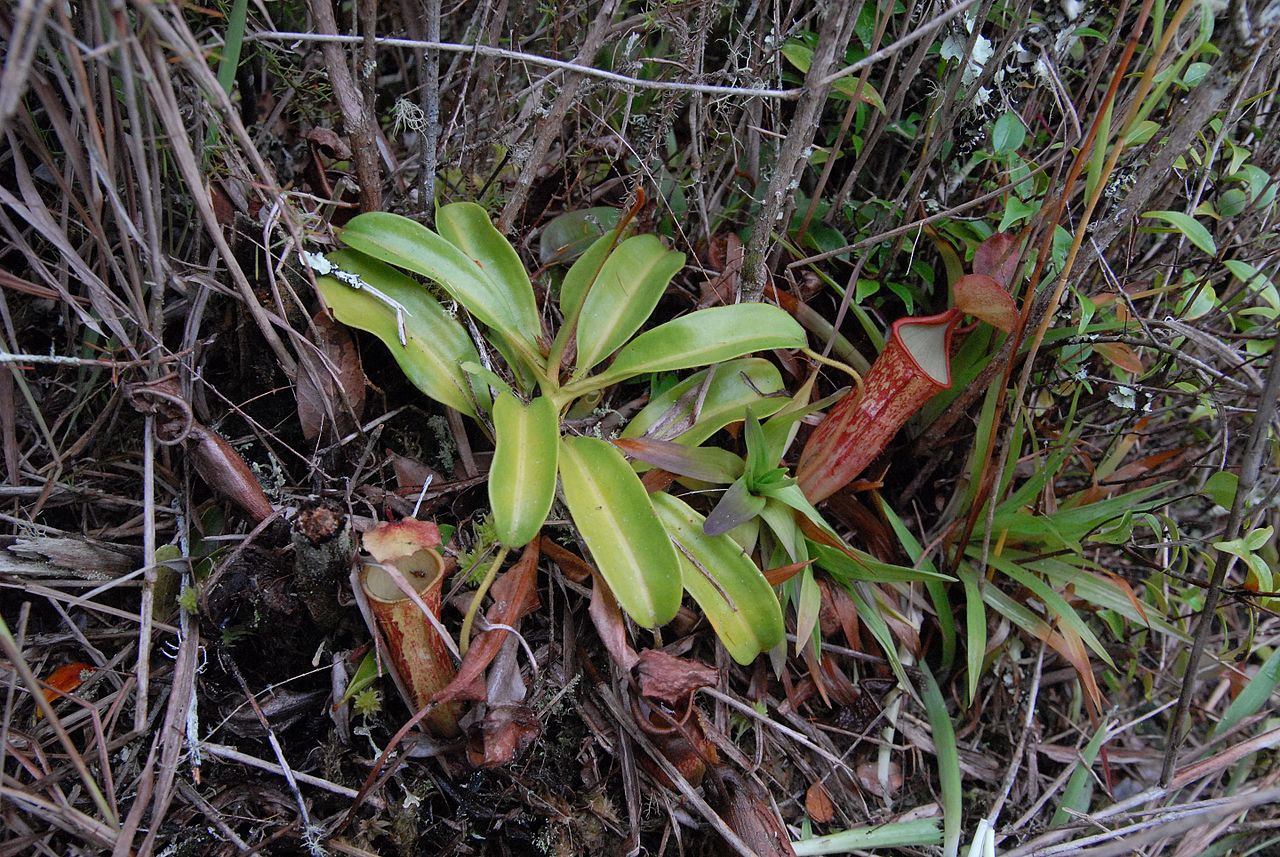
Image - Wikimedia / Thomas Gronemeyer
Nepentáceas are native to tropical and humid forests of the Old World, specifically China, Indonesia, Malaysia, the Philippines, Madagascar, Seychelles, Australia, New Caledonia, India and Sri Lanka. The genus to which they belong, Nepenthes, is made up of about 116 species, and they are known as pitcher plants or monkey cups, which refers to the fact that monkeys usually approach them to drink water from their traps.
They develop as climbing or prostrate plants, with a root system that is generally superficial and can be up to 15 meters long.. The leaves are alternate, lanceolate, green in color and up to 30 centimeters long. From the tip of the leaf the tendril emerges, which is used for climbing, and which is also where the trap arises. This trap contains a watery fluid, which is where the insects fall after being attracted by the smell produced by the Nepenthes' nectar glands. Once they fall, they die and their bodies are digested.
General ranking
When purchasing one, it is interesting to know that they are classified according to their altitude:
- Lowlands or Lowland: are those that live at low altitudes, up to 1000 meters above sea level. The climate is warm, with stable temperatures, and the humidity is very high.
- Highlands or Highland: they are those that we will find at altitudes between 1000 and 3000 meters. The climate is cooler, especially at night.
- Intermediate or Intermediate lands: In this group are the hybrids between lowland and highland Nepenthes.
What is the use of knowing this? Basically, to be able to take better care of them. For example, a lowland will need high temperatures and a much higher humidity than a lowland for example. In addition, if we live in an area where the climate is rather cool, it will be easier for us to maintain a highland area than a lowland area.
Main species
The best known are:
Nepenthes alata
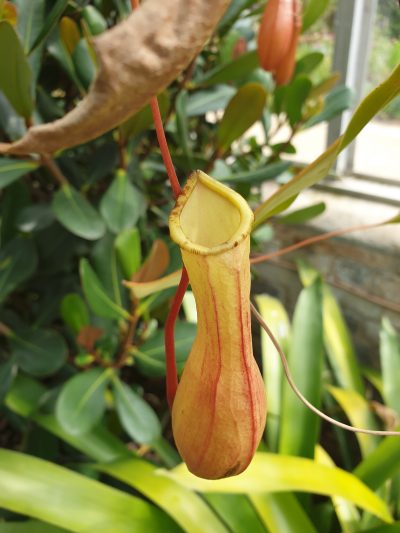
Image - Wikimedia / DenesFeri
La Nepenthes alata It is a carnivore native to the main islands of the Philippine archipelago. Its leaves are lanceolate-ovate, with a sharp or attenuated apex. The traps are about 10 centimeters long, and are usually reddish in color..
This species is still being studied, since depending on the region its characteristics differ somewhat from those believed to have. Thanks to the investigations that are being carried out it has been possible to create a new species, the Nepenthes eustachya, which has lanceolate leaves instead of lanceolate-ovate for example.
Nepenthes bicalcarata
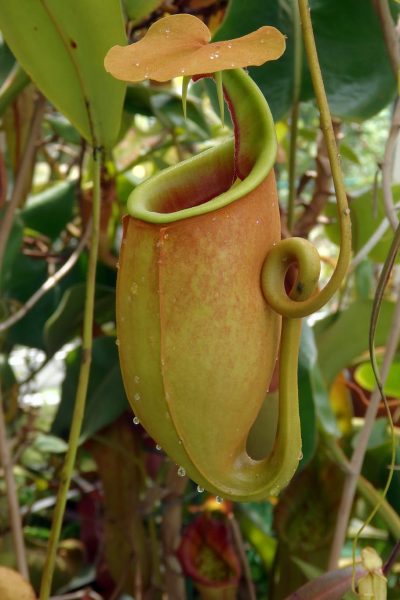
La Nepenthes bicalcarata, known as the tusked pitcher plant, is an endemic plant to northwestern Borneo, where it lives at low altitudes. It is a climber, being able to reach 20 meters in height, and its leaves are petiolate, obovate-lanceolate and up to 80 centimeters long. Its traps are yellowish.
Nepenthes hookeriana
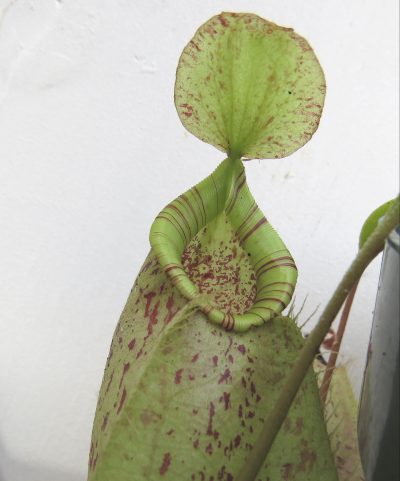
Image - Flickr / David Eickhoff
La Nepenthes hookeriana (o Nepenthes x hookeriana) is a natural hybrid of Nepenthes ampullaria x Nepenthes rafflesiana. It is native to the lowlands of Borneo, the Malaysian peninsula, Singapore, and Sumatra. The traps are small, about 5-7cm, green with irregular reddish spots.
nepenthes rajah
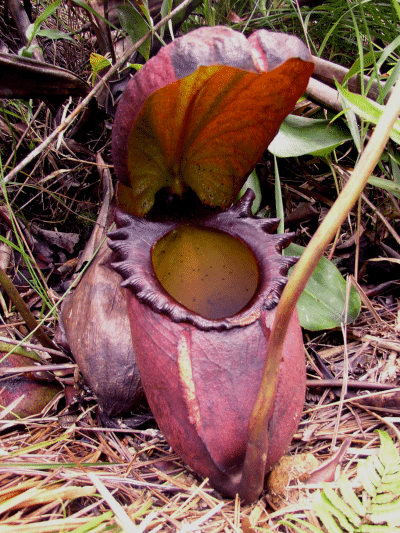
La nepenthes rajah it is a carnivore endemic to Mount Kinabalu, Borneo. It lives at altitudes between 1500 and 2650 meters, which is why it is considered to be a highland plant. It is a climber whose stem can reach 6 meters long, although it is rare that it exceeds 3m. Their traps are large, up to 41cm tall.
What is the care of the Nepenthes?
If you want to have a copy, we recommend that you provide it with the following care:
Location
- Body exterior:: these plants fear direct sun. They live under the shade of trees, either on top of branches or on the ground. You will like a place with light, but indirect.
- Interior: the room must be bright, and relatively high humidity, especially if it is a lowland species.
The pot to be used must be made of plastic, with holes in the base through which the water can escape when watering.
Irrigation
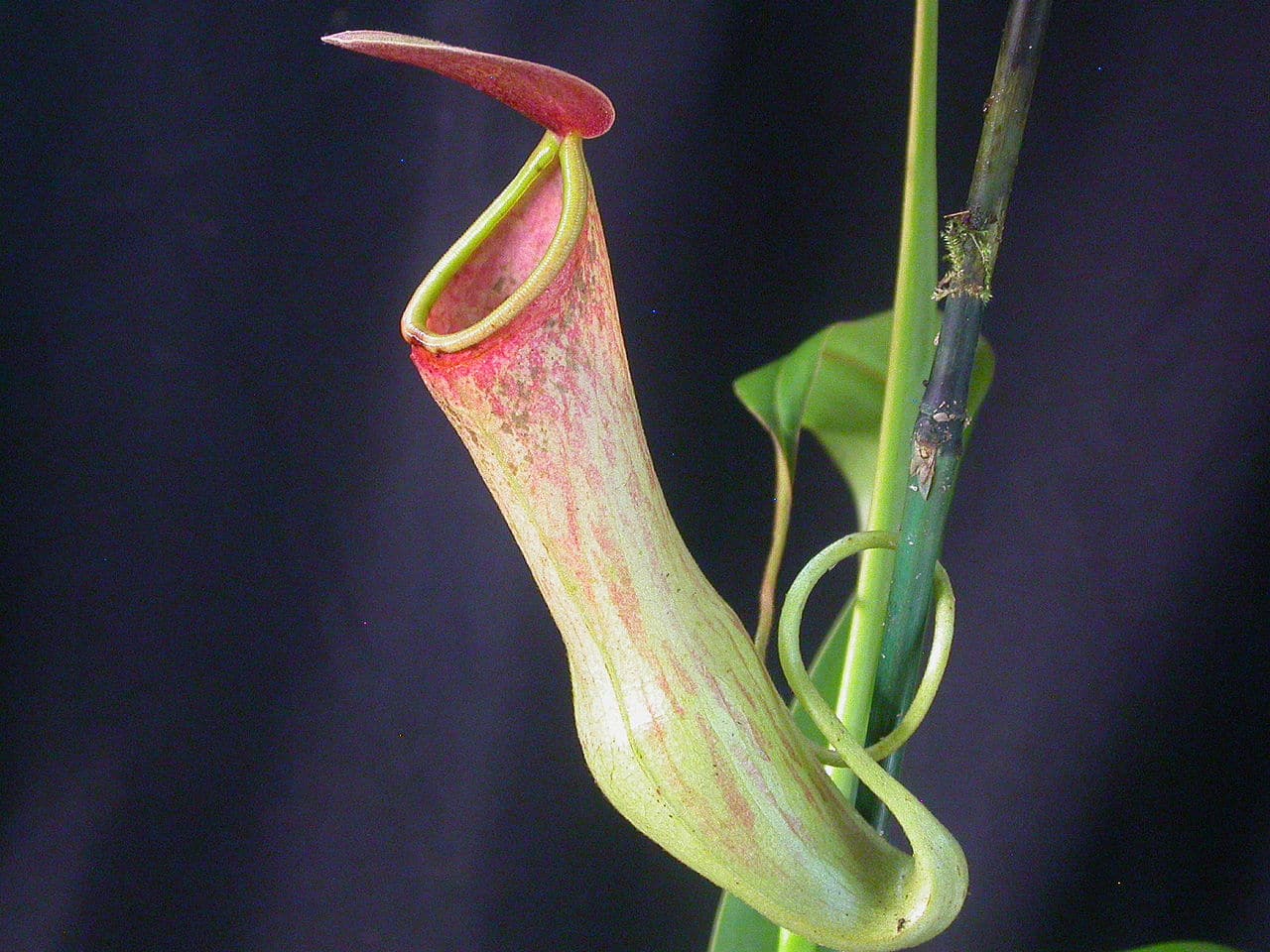
Image - Wikimedia / Thomas Gronemeyer
They should be watered with distilled, rain or osmosis water, several times a week, except in winter that we will space out the waterings a bit. The substrate must remain moist, but not waterlogged.
It is not recommended that they have a plate underneath (except in summer), since the roots could rot.
Substratum
Mix white peat not fertilized with perlite in equal parts.
Can it be paid?
No. They are plants that use their traps to get the nutrients they need, and do not accept any "extra food." The fertilizer, even if it is natural, can do a lot of damage to the roots which are not prepared to assimilate it, causing the death of the plant.
Multiplication
The Nepenthes multiply by seeds, which are sown in spring or summer in a plastic pot with substrate for carnivorous plants, or with a mixture of blond peat and perlite in equal parts.
Rusticity
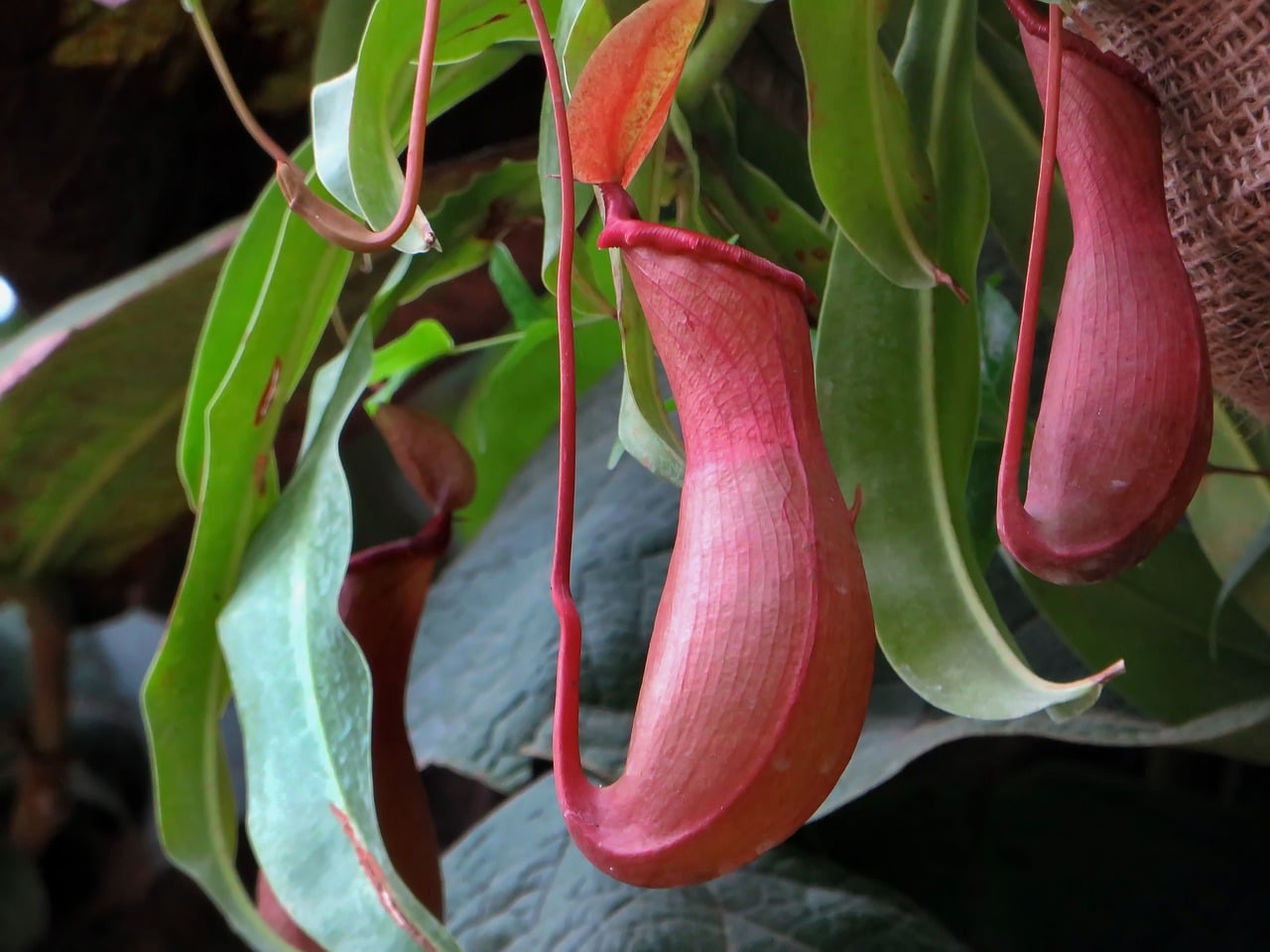
They are not easy plants, unless you live in a climate without frost, and with a high humidity. Nevertheless, there are several species that do support some weak frosts down to -1ºC as long as they are punctual and of short duration. They are as follows:
- Nepenthes »Rebekah Sopper»
- Nepenthes x sanguinea
- Nepenthes x ventrata, it is the most common in nurseries and garden stores
These three species are suitable for those who live in areas with a Mediterranean climate, or for those who live in sheltered areas, without strong frosts.
If we follow these tips, we will see our Nepenthes grow strong and healthy.
I have a ventrata nepenthes for 15 days, it is my first nepenthes. I have it in a gallery that faces the west but now the cold season is coming and in the gallery I do not have heating, I will have to move it. I would like you to advise me in which area of the house I would take it? I live in the interior of Galicia, in winter temperatures can reach -4.c
Hello Sea.
You can have it in the bathroom if a lot of natural light enters, since it will favor the humidity.
If not, in a room where there are no drafts will be fine.
A greeting.
I would like to know if I should put water in the jugs, in the florist where I bought it they said yes, but I have also heard that no. I'm Mila, from Galicia, thank you very much.
Hi Mila.
Congratulations on the purchase.
It is not necessary to pour water into the jugs. With the water that its roots obtain from the substrate, it will be enough.
A greeting.
Hello, good afternoon, I have a nepenthes and I have a doubt ... I passed it to another bigger pot but I passed it with everything and the soil with which it came and was wet, well ... And the special soil that I bought is dry, at least that the florist told me that there was no need to moisten the new soil, that just spraying the leaves 2 times a week was more than enough. Now ... My question is that how often is water given and is there a need to wet the earth? I know that if it is affirmative, you should not drown her bone ... Do not make puddles because ...
Hello Andrea.
The substrate of carnivorous plants must always be slightly damp. For this reason, I recommend you put a plate under it during the summer and fill it with soft water (without lime) so that the roots absorb it. The rest of the year it has to be watered by wetting the soil, two or three times a week maximum.
A greeting.
Hello, I have a Nepenthes x ventrata and it has not developed its jugs for more than 2 years. What I can do?
Hello Santiago.
It's funny what you say. Have you ever changed the pot? If you have not done so, it may be that it lacks soil (blond peat with 50% perlite).
And if you have, is it in a bright area? You cannot get direct sunlight, but it is important that you be in a place where there is plenty of light.
A greeting.
Hello, good afternoon.
I have a "Nepenthes x ventrata (alata x ventricosa)" and I see that it produces several jars, but they do not fully develop. That is to say, their jugs do not get a reddish hue but remain green and some do not reach their normal size.
Sometimes it has sprouts of jarritos that wither when small.
It is supposed to have the correct substrate because not long ago it was transplanted into a larger container.
The space where it is located has adequate humidity and abundant light (not direct)
I spray water on the leaves frequently and every 2 or 3 days direct irrigation on the ground, leaving no puddles.
what happen?
What does my plant need?
Thank you in advance for your response.
Greetings.
Hello Daniel.
Are you planted in blond peat? Is it irrigated with rainwater, distilled or lime-free? If the answers are yes, you are probably still recovering from the transplant.
Anyway, if you are in the northern hemisphere, now with the arrival of autumn and with winter just around the corner, it is normal that the traps of the carnivores are getting smaller and smaller, because the plant notices that the temperature is going going down and, in order to survive, it spends less and less energy producing leaves and traps.
A greeting.
I recently bought a nepenthes, it is the first, but the bags or jugs all dried up and some spots appeared on the leaves, reading I saw that the leaves have to be pulverized, which I did not know and I am looking for land for it I exposed to the sun, little because in Asturias it comes to us with a dropper, could you help me save it please, thank you
Hi Soly.
Put it in semi-shade (it does not have to be in direct sunlight) and irrigate with lime-free water.
The soil has to be peat moss mixed with a little bit of pearlite.
A greeting.
Very good article for those of us who are in this interesting world of carnivorous plants, in my case I have a nepenthes in my bathroom and I'm doing well, the plant remains healthy
We are glad you liked it. And congratulations on that nephentes!
Good night, that is due to the change of color in the leaves of the nepenthes and to the fact that the tips of the leaves dry when the jugs just start to come out I have 5 nepenthes I'm from Colombia Zipaquirá north of Bogotá I don't know how and where I can send you photos, God BLESS you thank you
Hello Gloria Teresa.
Does the sun shine on you at any time of the day? It is important not to give it as it cannot stand it.
You also have to water it several times a week, so it does not dry out. If the humidity is low, and the climate is dry, that can prevent the jugs from developing normally, so you have to pulverize (spray) them with rain or distilled water.
Greetings.
Hello, very good day. I just bought a small nepenthes and I would like to know if it would be advisable to make a small terrarium or something like that to keep the humidity around it high or it will be enough with the humidity that the environment has.
I have 3 other carnivorous plants but don donuts and sundew, whose care is easier than a nepenthes.
Hello david.
If you live in an area where the humidity is already high, such as an island or near the coast, then you don't have to do anything else 🙂
But if, on the other hand, the humidity is low, less than 50%, then you could put containers with water around the pot.
To know the humidity in the place where you live, you can consult any weather forecast website, or even put in Google: weather in X (changing the X for the name of your town / city).
Regards!